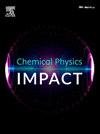Curcumin loaded biocompatible polymer embedded silver nanoparticles: A photophysical study on new photosensitizer composite
IF 4.3
Q2 CHEMISTRY, PHYSICAL
引用次数: 0
Abstract
Drug delivery is a process that involves effective therapeutic delivery of drugs that we usually use in medical treatments like Photodynamic therapy (PDT) as adopted for cancer treatment. Polyphenyl curcumin (CUR) is one of the major ingredients of rhizome of turmeric. CUR is a photosensitizer molecule whose photosensitizing properties can be enhanced by associating it with pharmaceutical excipients like Polyvinyl pyrrolidone (PVP) and Polyethylene glycol (PEG). Nanoparticles have been widely used in various fields of research due to their unique properties. Silver nanoparticles (AgNPs) are found to have anti-proliferative properties that may increase the ease of drug delivery at the site of physiological action when associated with the drug molecule. The association of CUR with AgNP can be probable photosensitizer system, which can be used in PDT and PDD. In the current work, the fluorescence property of CUR was used to evaluate the AgNP-embedded CUR. The effect of PVP and PEG on AgNP–CUR was analyzed through photophysical studies. The results showed that there is an effective the solubilization and bioavailability of CUR is improvised by using PVP and PEG as well as in mixed polymer system. The observed fluorescence quenching in the presence of AgNPs indicates a strong interaction between CUR consequently reduces the CUR fluorescence. Dynamic light scattering (DLS) analysis revealed that the Z-average of AgNPs was 39.12 nm, which increased to 49.50 nm upon CUR addition. Zeta potential measurements showed a reduction from -32.38 mV (AgNPs) to -23.10 mV (CUR-AgNPs), indicating strong CUR–AgNP interaction.

姜黄素载生物相容性聚合物包埋纳米银:新型光敏剂复合材料的光物理研究
药物输送是一个涉及药物有效治疗的过程,我们通常在医学治疗中使用,如用于癌症治疗的光动力疗法(PDT)。多苯姜黄素(Polyphenyl curcumin, CUR)是姜黄根茎的主要成分之一。CUR是一种光敏剂分子,其光敏性可以通过与聚乙烯醇吡咯烷酮(PVP)和聚乙二醇(PEG)等药用赋形剂结合而增强。纳米粒子由于其独特的性质,已广泛应用于各个研究领域。银纳米颗粒(AgNPs)被发现具有抗增殖特性,当与药物分子结合时,可能会增加药物在生理作用部位传递的便利性。CUR与AgNP的结合可能是光敏剂体系,可用于PDT和PDD。本研究通过对agnp包埋的CUR的荧光特性进行评价,通过光物理研究分析PVP和PEG对AgNP-CUR的影响。结果表明,PVP和PEG以及混合聚合物体系均能有效提高CUR的增溶性和生物利用度。在AgNPs存在下观察到的荧光猝灭表明,CUR之间存在强相互作用,从而降低了CUR的荧光。动态光散射(DLS)分析表明,AgNPs的z -平均值为39.12 nm,加入CUR后增加到49.50 nm。Zeta电位测量显示从-32.38 mV (AgNPs)降至-23.10 mV (CUR-AgNPs),表明curp - agnp相互作用强。
本文章由计算机程序翻译,如有差异,请以英文原文为准。
求助全文
约1分钟内获得全文
求助全文
来源期刊

Chemical Physics Impact
Materials Science-Materials Science (miscellaneous)
CiteScore
2.60
自引率
0.00%
发文量
65
审稿时长
46 days
 求助内容:
求助内容: 应助结果提醒方式:
应助结果提醒方式:


